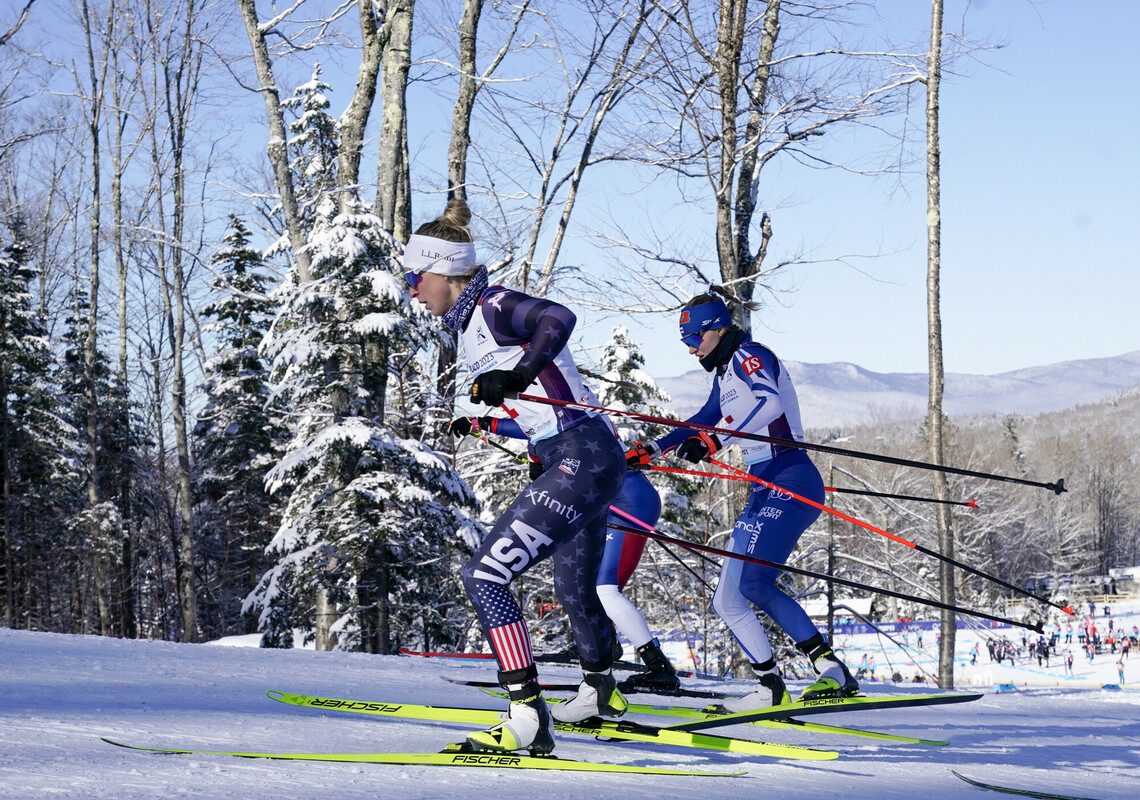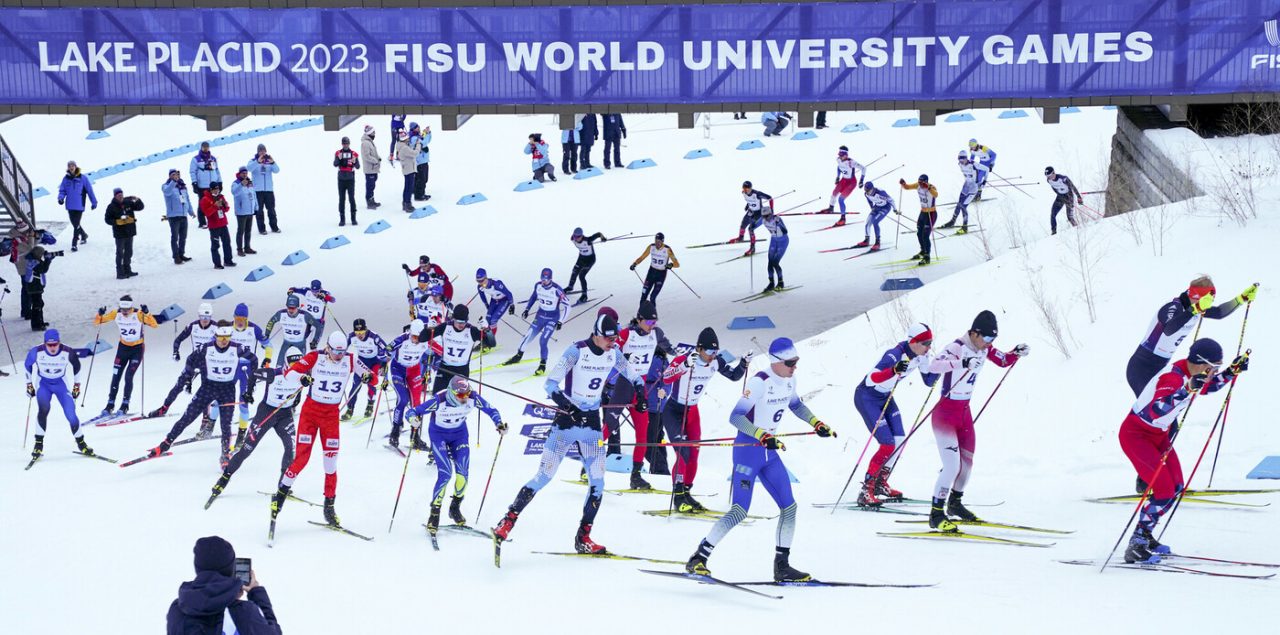 This coverage is made possible through the generous support of Marty and Kathy Hall and A Hall Mark of Excellence Award. To learn more about A Hall Mark of Excellence Award, or to learn how you can support FasterSkier’s coverage, please contact info@fasterskier.com.
This coverage is made possible through the generous support of Marty and Kathy Hall and A Hall Mark of Excellence Award. To learn more about A Hall Mark of Excellence Award, or to learn how you can support FasterSkier’s coverage, please contact info@fasterskier.com.

The Minneapolis World Cup was a sensational success. Now, the announcement of the upcoming vote on Lake Placid as a host venue for a cross-country World Cup weekend has kindled hopes of another hugely enjoyable and exciting experience for North American fans. But it takes more than just hope and aspiration to be seriously considered to host a World Cup, and to actually land the big date takes even more. Earlier this month, FasterSkier looked at what it took to get the nod for Lake Placid from the United States Ski and Snowboard and FIS (International Ski Federation) perspective. But there’s another entire story from the venue’s perspective. Here’s a look at what folks in New York needed to do to get to the point where they are just one step away from being ratified as a World Cup site.

To start with, Lake Placid’s organization is structured very differently from that in Minneapolis. Lake Placid is already an international venue with facilities and government sponsored organizational structure in place to handle large events. Minneapolis was a much smaller venue organized mostly by volunteers and non-profits without an existing state agency to run the event.
To understand those differences—and what’s behind Lake Placid’s bid—FasterSkier spoke with Kris Seymour who is Nordic Program Coordinator overseeing recreation activities, sport development activity, and all of the endurance events that take place at Mt. Van Hoevenberg, Lake Placid.
Seymour works for the Olympic Regional Development Authority (ORDA), a state agency dedicated to the management of Lake Placid’s Olympic facilities. ORDA is a byproduct of the Lake Placid Olympics of 1980 and 1932. Its mission statement is: “To create economic and social benefit in the Adirondacks and Catskills by operating year-round venues that provide recreational and athletic development opportunities, achieved through a commitment to continuous improvement and emphasis on environmental stewardship, fiscal responsibility, and the delivery of world-class programs and experiences to persons of all ages and abilities.” That’s a pretty broad mandate, but it’s the part about delivery of world-class programs and experiences that lays the foundation for ORDA going after big international events like the FIS World Cup.

Bringing a World Cup to Mt. Van Hoevenberg has been a long time coming. The last time there was a cross-country World Cup event in Lake Placid was in 1979 before the Olympics. “A really important part of our mandate is to go after high level national and international events,” said Seymour. “It’s pretty unique.” Mt. Van Hoevenberg has hosted national and international events in bobsled, skeleton, luge, and cross-country (skiing). This September, it will expand to include International Cycling Union (UCI) World Cup Mountain biking. “For us the 2026 finale— the proposed races would be the last weekend of the season— in cross-country skiing has been a long time goal…and has also been one of our major accomplishments.”
Lots of Upgrades
Forty-seven years between visits is a long time, but that doesn’t mean ORDA has been waiting around just hoping that FIS will revisit the Adirondacks. “The goal (of a World Cup) has been longstanding, going back to the early 2000s,” said Seymour. “We knew that Mt. Van Hoevenberg needed to go through a revitalization and re-homologation period.” Given the venue’s location, this presented some additional hurdles. “We’re on state land, so the level of revitalization which needed to happen had regulatory and other environmental milestones which needed to be met. Those took a number of years. About 6-7 years ago Lake Placid was coming into a new era. Our governor at the time—Andrew Cuomo— was very interested in the revitalization of all of the Olympic venues in Lake Placid. He wanted all of those venues to be to international standards.”
It was the confluence of many factors that ultimately resulted in the World Cup bid. But the spark that led to the hosting fire was the World University Games coming to Lake Placid in 2023. “That event became the piece where the state of New York invested money into Lake Placid as both a community and invested in the Olympic venues for revitalization,” said Seymour. “This led to the creation of one venue at Mt. Van Hoevenberg which could host World Cup biathlon and cross-country. 2018 was the start of master planning for the World University Games which led to a closer look at how ORDA could create a single site for cross-country and biathlon. That’s when the process for becoming a World Cup venue really began. It’s when the benchmarking for the courses to hold a World Cup occurred. The process involved having FIS appoint an homologation inspector and designer (homologation is a big word which simply refers to the process and standards of having a course approved to meet FIS World Cup standards).”

Having an approved course for biathlon, Nordic combined, and cross-country presented challenges since the homologation standards are different. “It is achievable, which we did at Mt. Van Hoevenberg. We held the University games for cross-country, biathlon, and Nordic combined at the same venue, which isn’t typical. It was a pretty significant accomplishment to do all these events over a two week period. Bringing the world in…gave us the chance— in a pretty condensed amount of time— to gain a lot of experience by working with both the athletes and the international organizations.”
The longest loop on the homologated course is a five-kilometer section with small loops built around it as required for biathlon and cross-country. “We have future plans for expansion, but that’s a few years away.”

With all of the changes, Mt. Van Hoevenberg brings a lot to the table in addition to simply having an international level ski trail. “The infrastructure development has become a differentiator,” Seymour explained. “We built a lodge that’s over 50,000 square feet, there are facilities specific to recreation, sport development, competition, and event management. Inside that space is all of the room we need for timing and scoring as well as broadcasting and jury rooms. We looked at what FIS and the IBU (International Biathlon Union) required and created those permanently within the lodge. Having this level of infrastructure in place is a game changer for governing organizations and host venues.”
This means that to host future events, ORDA doesn’t have to build or bring in temporary structures and also has the space for other uses. “Those spaces also serve other important needs…such as using those spaces for meetings or social activities. It’s been really positive for us.” Also created during the rehabilitation was the establishment of permanent team areas for waxing. These meet FIS standards for heating and ventilation and are adjacent to the stadium through a tunnel. “We use those for everything from a high school race to family spaces.”

Lake Placid also took visionary steps to make itself appealing for large international events by creating a plug-and-play technology footprint for broadcasting. “One of the biggest things we did—which isn’t done by a lot of our contemporaries—is we established a dedicated broadcast, I.T., and scoring system,” Seymour explained. “Throughout the trail network we have over 20 media pedestals. Each has power, data, and fiber. When T.V. comes to the event, Mt. Van Hoevenberg is literally a plug-and-play; they don’t have to lay miles of cable. This became a big differentiator (compared to other venues). If we didn’t have that, broadcast has to come in a week early. Instead, they can show up a couple of days before the event which saves everyone money.” This permanent infrastructure has eliminated the need for most cable runs. “All of the pedestals are linked to a server room, so everything is plug and play to make it easy for broadcasters. This technology support is viewed very favorably by international organizations. This infrastructure played a big role in Mt. Van Hoevenberg being approached by UCI to be a World Cup Mountain bike host.”
Additional infrastructure upgrades were also needed to deal with the always-present issues driven by climate change. Snowmaking is now an important consideration for venues; Lake Placid is no exception. Before revitalization projects began, Mt. Van Hoevenberg didn’t have snowmaking. It was an enormous undertaking to add snowmaking to the facility. “We created a reservoir site of just over 3,000,000 gallons, that’s within the trail network, we have a snowmaking pumphouse feeding the course. Every 60-80 feet is an air and water hydrant with high efficiency snow guns. In the stadium there are three fan guns. After completion it was recognized by FIS as one of the most capable and powerful systems on the planet. There are five kilometers of snow making, and all of the competition loops sit within those five kilometers. Additionally, there’s another kilometer of snowmaking in the warmup loop. Since adding snowmaking, despite the significant weather challenges, Lake Placid hasn’t had to cancel any races in the last four seasons.”
While snowmaking is becoming a baseline requirement for an international venue, Lake Placid may have a leg up on other venues for other reasons when it comes to ski conditions. “Looking at climate models, Lake Placid is fairly well poised for cold temperatures. We should still—through the middle of the century—have significant cold windows.”
Four years ago, ORDA began serious conversations with Stifel U.S. Ski Team Program Director, Chris Grover, and head coach, Matt Whitcomb, about hosting an event. The idea of timing a World Cup at Lake Placid to intersect with the career arc of current U.S. team stars was a natural consideration. “That became a conversation—of certain windows—with the season finale being an obvious window,” said Seymour. “We’re not assuming that anyone is retiring after the Olympics, but recognizing that for some athletes, that is a time…it was identified as a perfect window for the rising stars and the more experienced parts of the team—potentially on home soil—to be able to shine…in front of what’s expected to be a robust crowd.”
Please return to FasterSkier for Part II of our interview with Kris Seymour to learn more about what it took for Lake Placid to rise to the level of being a World Cup host venue.





